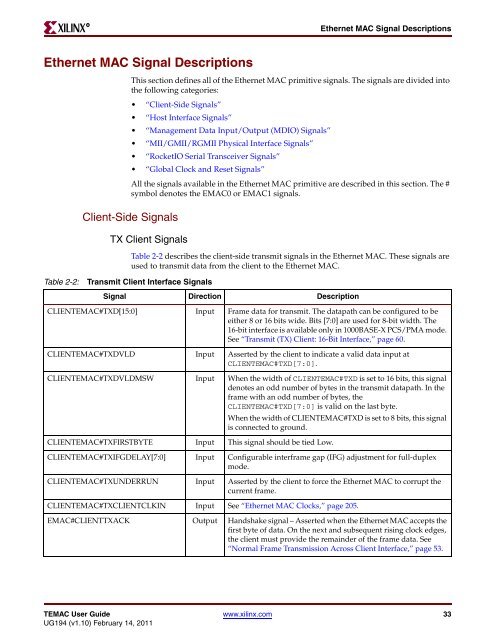Xilinx UG194 Virtex-5 FPGA Embedded Tri-Mode Ethernet MAC ...
Xilinx UG194 Virtex-5 FPGA Embedded Tri-Mode Ethernet MAC ...
Xilinx UG194 Virtex-5 FPGA Embedded Tri-Mode Ethernet MAC ...
Create successful ePaper yourself
Turn your PDF publications into a flip-book with our unique Google optimized e-Paper software.
R<br />
<strong>Ethernet</strong> <strong>MAC</strong> Signal Descriptions<br />
<strong>Ethernet</strong> <strong>MAC</strong> Signal Descriptions<br />
This section defines all of the <strong>Ethernet</strong> <strong>MAC</strong> primitive signals. The signals are divided into<br />
the following categories:<br />
“Client-Side Signals”<br />
“Host Interface Signals”<br />
“Management Data Input/Output (MDIO) Signals”<br />
“MII/GMII/RGMII Physical Interface Signals”<br />
“RocketIO Serial Transceiver Signals”<br />
“Global Clock and Reset Signals”<br />
All the signals available in the <strong>Ethernet</strong> <strong>MAC</strong> primitive are described in this section. The #<br />
symbol denotes the E<strong>MAC</strong>0 or E<strong>MAC</strong>1 signals.<br />
Client-Side Signals<br />
TX Client Signals<br />
Table 2-2: Transmit Client Interface Signals<br />
Table 2-2 describes the client-side transmit signals in the <strong>Ethernet</strong> <strong>MAC</strong>. These signals are<br />
used to transmit data from the client to the <strong>Ethernet</strong> <strong>MAC</strong>.<br />
Signal Direction Description<br />
CLIENTE<strong>MAC</strong>#TXD[15:0] Input Frame data for transmit. The datapath can be configured to be<br />
either 8 or 16 bits wide. Bits [7:0] are used for 8-bit width. The<br />
16-bit interface is available only in 1000BASE-X PCS/PMA mode.<br />
See “Transmit (TX) Client: 16-Bit Interface,” page 60.<br />
CLIENTE<strong>MAC</strong>#TXDVLD Input Asserted by the client to indicate a valid data input at<br />
CLIENTE<strong>MAC</strong>#TXD[7:0].<br />
CLIENTE<strong>MAC</strong>#TXDVLDMSW Input When the width of CLIENTE<strong>MAC</strong>#TXD is set to 16 bits, this signal<br />
denotes an odd number of bytes in the transmit datapath. In the<br />
frame with an odd number of bytes, the<br />
CLIENTE<strong>MAC</strong>#TXD[7:0] is valid on the last byte.<br />
When the width of CLIENTE<strong>MAC</strong>#TXD is set to 8 bits, this signal<br />
is connected to ground.<br />
CLIENTE<strong>MAC</strong>#TXFIRSTBYTE Input This signal should be tied Low.<br />
CLIENTE<strong>MAC</strong>#TXIFGDELAY[7:0] Input Configurable interframe gap (IFG) adjustment for full-duplex<br />
mode.<br />
CLIENTE<strong>MAC</strong>#TXUNDERRUN Input Asserted by the client to force the <strong>Ethernet</strong> <strong>MAC</strong> to corrupt the<br />
current frame.<br />
CLIENTE<strong>MAC</strong>#TXCLIENTCLKIN Input See “<strong>Ethernet</strong> <strong>MAC</strong> Clocks,” page 205.<br />
E<strong>MAC</strong>#CLIENTTXACK Output Handshake signal – Asserted when the <strong>Ethernet</strong> <strong>MAC</strong> accepts the<br />
first byte of data. On the next and subsequent rising clock edges,<br />
the client must provide the remainder of the frame data. See<br />
“Normal Frame Transmission Across Client Interface,” page 53.<br />
TE<strong>MAC</strong> User Guide www.xilinx.com 33<br />
<strong>UG194</strong> (v1.10) February 14, 2011

















